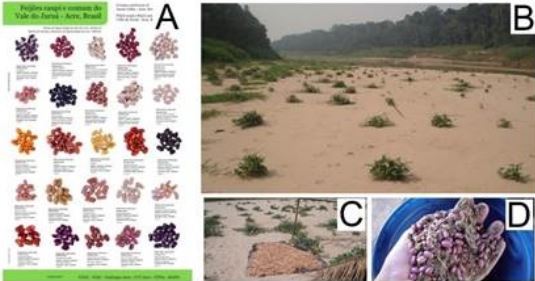Método tradicional de almacenamiento de granos y semillas de caupi para el control de insecto-plaga
Contenido principal del artículo
Resumen
Este trabajo tuvo como objetivo evaluar la eficiencia del método tradicional de almacenamiento de granos y semillas de caupí para el control del gorgojo, Callosobruchus maculatus (Fabr.) (Coleoptera: Bruchidae). El método de almacenamiento consiste en empaquetar granos y semillas mezclados con los residuos resultantes del trillaje en botellas o barriles de polietileno sellados herméticamente. En el experimento se evaluaron cuatro tratamientos: (i.) frasco perforado que contiene granos, (ii.) frasco no perforado que contiene granos, (iii.) frasco perforado que contiene una mezcla de granos y residuos del trillaje y (iv.) frasco no perforado que contiene una mezcla de granos y residuos del trillaje; este último, representando el método tradicional (control). Para cada tratamiento se utilizaron 4 réplicas y para cada frasco se insertaron 20 individuos adultos del insecto plaga. Después de la infestación inducida, los frascos se almacenaron en un lugar protegido de la lluvia y el sol, simulando la realidad del almacenamiento de los agricultores. A los 35 y 70 días después de la infestación inducida, se evaluaron las siguientes variables para cada frasco: número de insectos vivos, número de insectos muertos, número de agujeros causados por insectos en los granos y porcentaje de granos atacados. El uso de residuos resultantes del trillaje no fue eficiente para el control. Por otro lado, la ausencia de intercambio de gases en los frascos redujo la multiplicación de insectos, lo que indica la importancia de utilizar barriles herméticos o bolsas de vacío para el almacenamiento y la comercialización.
Detalles del artículo

Esta obra está bajo una licencia internacional Creative Commons Atribución-NoComercial 4.0.
Aquellos autores/as que tengan publicaciones con esta revista, aceptan los términos siguientes de la Licencia CC Reconocimiento-NoComercial 4.0 Internacional (CC BY-NC 4.0):
Usted es libre de:
- Compartir — copiar y redistribuir el material en cualquier medio o formato
- Adaptar — remezclar, transformar y crear a partir del material
El licenciador no puede revocar estas libertades mientras cumpla con los términos de la licencia.
Bajo las condiciones siguientes:
- Reconocimiento — Debe reconocer adecuadamente la autoría, proporcionar un enlace a la licencia e indicar si se han realizado cambios. Puede hacerlo de cualquier manera razonable, pero no de una manera que sugiera que tiene el apoyo del licenciador o lo recibe por el uso que hace.
- NoComercial — No puede utilizar el material para una finalidad comercial.
- No hay restricciones adicionales — No puede aplicar términos legales o medidas tecnológicas que legalmente restrinjan realizar aquello que la licencia permite.
La revista no se responsabiliza con las opiniones y conceptos emitidos en los trabajos, son de exclusiva responsabilidad de los autores. El Editor, con la asistencia del Comité de Editorial, se reserva el derecho de sugerir o solicitar modificaciones aconsejables o necesarias. Son aceptados para publicar trabajos científico originales, resultados de investigaciones de interés que no hayan sido publicados ni enviados a otra revista para ese mismo fin.
La mención de marcas comerciales de equipos, instrumentos o materiales específicos obedece a propósitos de identificación, no existiendo ningún compromiso promocional con relación a los mismos, ni por los autores ni por el editor.
Citas
Kébé K, Alvarez N, Tuda M, Arnqvist G, Fox CW, Sembène M, et al. Global phylogeography of the insect pest Callosobruchus maculatus (Coleoptera: Bruchinae) relates to the history of its main host, Vigna unguiculata. Journal of Biogeography. 2017;44(11):2515-2526. doi: 10.1111/jbi.13052.
CABI Invasive Species Compendium. Wallingford, UK: CAB International. 2020. Available from: http://www.cabi.org/isc. 2020.
Mattar EPL, Oliveira E de, Jesus JC da S, Araújo ML de, Siviero A, Santos Junior HC dos. Creolo beans production systems in Juruá valley, Acre, Brazilian Amazon. Indian Journal of Traditional Knowledge. 2016;15(4):619-624.
Mattar EPL, Oliveira E de, Jesus JC da S, Araújo ML de, Nagy ACG. Colheita e secagem. En: Mattar EPL, Oliveira, E de; Santos, RC dos; Siviero, A (Org.). Feijões do Vale do Juruá. IFAC; 2017 p. 217-222, Rio Branco, Brazil.
Primavesi A. Manejo ecológico de pragas e doenças: técnicas alternativas para a produção agropecuária e defesa do meio ambiente. São Paulo, Brazil: Expressão Popular.; 2016. 144 p.
Prakash, BG, Raghavendra K V, Gowthami R, Shashank R. Indigenous practices for eco-friendly storage of food grains and seeds. Adv Plants Agric Res. 2016;3(4):101-107. doi: 10.15406/apar.2016.03.00101.
Lawrence B, Bicksler AJ, Duncan K. Local treatments and vacuum sealing as novel control strategies for stored seed pests in the tropics. Agron. Sustain. Dev. 2017;37(6). doi: 10.1007/s13593-017-0415-0. Available from: https://link.springer.com/content/pdf/10.1007/s13593-017-0415-0.pdf
Duarte AF. Aspectos da climatologia do Acre, Brasil, com base no intervalo 1971 - 2000. Revista Brasileira de Meteorologia. 2006;21(3b):308-317.
R Development Core Team R: A language and environment for statistical computing. R Foundation for Statistical Computing, Vienna, Áustria, 2016. Available from: http://www.R-project.org
Silva MGC, Silva GN, Sousa AH, Freitas RS, Silva MSG, Abreu AO. Hermetic storage as an alternative for controlling Callosobruchus maculatus (Coleoptera: Chrysomelidae) and preserving the quality of cowpeas. Journal of Stored Products Research. 2018;78:27-31. doi: 10.1016/j.jspr.2018.05.010
Njoroge AW, Mankin RW, Smith BW, Baributsa D. Oxygen consumption and acoustic activity of adult Callosobruchus maculatus (F.) (Coleoptera: Chrysomelidae: Bruchinae) during hermetic storage. Insects. 2018;9(2):45. doi:10.3390/insects9020045. Available from: https://www.ncbi.nlm.nih.gov/pmc/articles/PMC6023381/pdf/insects-09-00045.pdf
Daglish GJ, Jagadeesan R, Nayak MK. Temperature-dependent development and reproduction of the cowpea weevil, Callosobruchus maculatus F., in mungbean: Estimating a target temperature for its control using aeration cooling. Journal of Stored Products Research. 2021;92. doi: 10.1016/j.jspr.2021.101815. Available from: https://www.sciencedirect.com/science/article/pii/S0022474X21000540
Kumar S, Mohapatra D, Kotwaliwale N, Singh KK. Vacuum Hermetic Fumigation: A review. Journal of Stored Products Research. 2017;71:47-56. doi: 10.1016/j.jspr.2017.01.002
Barbosa FR, Yokoyama M., Pereira PAA, Zimmermann FJP. Controle do caruncho-do-feijoeiro Zabrotes subfasciatus com óleos vegetais, munha, materiais inertes e malathion. Pesq. agropec. bras. 2002;37(9):1213-1217. doi: 10.1590/S0100-204X2002000900002
Alecio MR, Fazolin M, Coelho Netto RA, Catani V, Estrelas JLV, Alves SB, et al. Ação inseticida do extrato de Derris amazónica Killip para Cerotoma arcuatus Olivier (Coleoptera: Chrysomelidae. Acta Amaz. 2010;40(4):719-728. doi: 10.1590/S0044-59672010000400012.
